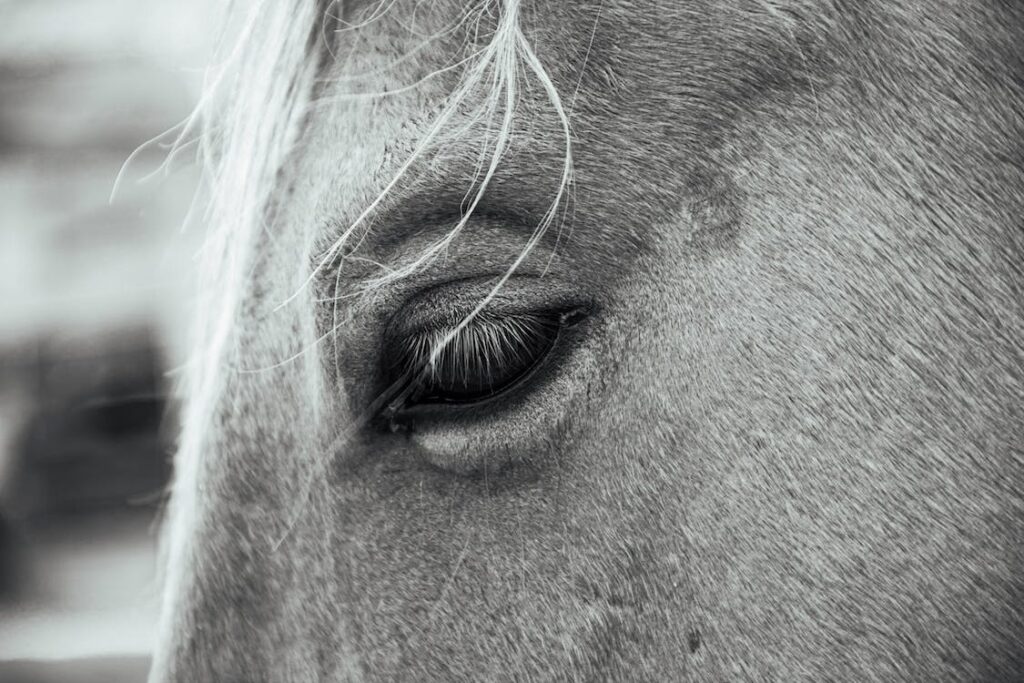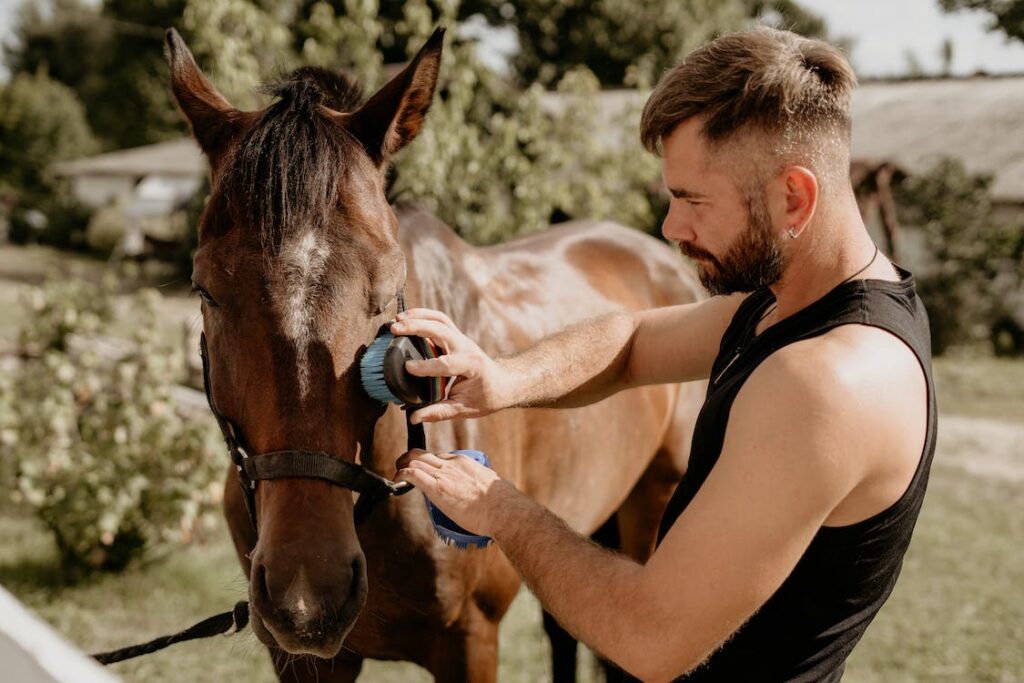Horse with Cushing’s One of the most complex decisions a horse owner faces is knowing when it’s time to say goodbye to their equine companion. This is especially true when the horse has been diagnosed with Cushing’s disease, a common hormonal disorder in older horses. Cushing’s can often be managed for many years with medication and care. However, as the disease advances, a point comes when treatment no longer provides an acceptable quality of life. Recognizing when your Cushing’s horse has reached this stage and deciding to end its suffering humanely is devastating yet necessary.
Table of Contents
What is Cushing’s Disease?

Cushing’s disease, also known as PPID (pituitary pars intermedia dysfunction), develops when a non-cancerous tumour affects the pituitary gland located at the base of the brain. This causes an overproduction of hormones that regulate metabolism and other bodily processes. The excess hormones create a range of symptoms, including:
- Delayed shedding of the winter coat
- Muscle wasting
- Increased appetite and thirst
- Frequent infections
- Laminitis
While the root cause is still unknown, we know Cushing’s mainly arises in horses over 15 years old. Certain breeds, like ponies and Morgans, are genetically predisposed. A diagnosis is made by a vet using blood tests to measure hormone levels.
Caring for a Cushing’s Horse
Catching Cushing’s early and beginning treatment helps control symptoms and prolong the quality of life. Most horses do well for years on oral medications like pergolide. Lifestyle adjustments are also vital:
- low-sugar diet to minimize insulin resistance
- Careful hoof management to prevent laminitis
- More extensive grooming for the long coat
- Regular exercise if the horse is sound
- Close monitoring and vet checkups
With diligent management, a PPID diagnosis does not have to mean the end. But the disease is progressive, and eventually a time comes when treatment cannot hold back the effects.
Signs that quality of Life is Declining
Cushing affects each horse differently. Your vet can best advise you when your horse’s condition is deteriorating irreversibly. But there are some general symptoms and signs that the disease has reached its final stages:
- Loss of appetite: chronic weight loss despite feeding assistance
- Recurring laminitis: no longer responding to treatment
- Inability to chew food: mouth pain or few or no teeth left
- Lethargy: little interest in surroundings or herd
- Laboured breathing suggests organ failure
- Severe muscle wasting leaves horses weak and unsteady
- Non-healing infections – Resistant to medications
- Lack of pain relief: discomfort is not manageable with drugs
Seeing your once vibrant friend decline despite your efforts takes a heavy emotional toll. But exploring all options first helps ensure you have done all you can before considering euthanasia.
Options as the End Nears
As difficult as it is, objectively examine your Cushing’s horse’s current welfare. In the end, ask yourself:
- Is my horse still enjoying any part of life – meals, turnout, grooming, interactions?
- Am I keeping my friend alive for myself when they are ready to go?
- Is my horse’s continuing discomfort manageable? At what point is it inhumane?
- Have I explored palliative care like pain medication, dietary changes, and veterinary hospice?
- Are safety concerns rising? Could a seizure or collapse risk injury?
If you find your horse’s suffering outweighs any remaining quality of life, humane euthanasia may be the final act of love and duty we owe our animals. Please consult your vet when your horse’s system seems too far gone, and note their recommendation on timing. While always heartbreaking, ending unnecessary pain is a courageous gift we can offer.
You Might Also like: CAN HORSES EAT BLUEBERRIES?
Saying Goodbye
The euthanasia decision is intensely personal, so only you know when it suits your situation. Seek support from your vet, family, and friends. Consider having someone with you for comfort and to care for your other horses if needed. If possible, plan to be present during the procedure so your horse is among familiar people and surroundings in their final moments.
Honour your friend by reflecting on the joy they brought you. Know that while the time was painfully short, your caring and dedication greatly enriched the life they did have. Allow yourself to fully grieve and process the loss of a beloved equine partner. The hurt never entirely fades but eventually makes room for fond remembrances. Though gone, the spirit of your particular Cushing’s horse will live on in your heart. Their light illuminated your path, even if only briefly.
Tips for Preventing Cushing’s Disease
While we cannot stop Cushing’s from developing as horses age, specific strategies may help reduce the risk:
- Keep the horse at an ideal weight to avoid insulin resistance
- Have the vet perform annual checkups to monitor for signs of
- Test for Cushing’s by age 15, even without symptoms
- Feed a low-glycemic and low-carb diet
- Limit grazing spring and fall pastures to reduce sugars
- Provide nutritional supplements that support adrenal health
- Manage diet and exercise to maintain fitness into old age
Early detection and proactive care give a Cushing’s horse the best chance of many healthy years. But when the disease outpaces treatment, say farewell, knowing you maximized the time you had together.
Carefully Selecting the Right Diet for Horses with Cushing’s Disease
When caring for a horse diagnosed with Cushing’s disease, one of the most important management strategies is tailoring their diet plan. As PPID creates metabolic changes that lead to insulin resistance, controlling blood sugar levels through proper nutrition is essential.
Avoiding foods high in non-structural carbohydrates like starch or sugar is crucial. These simple sugars are quickly broken down into glucose, spiking blood insulin and potentially leading to laminitis flare-ups. Instead, aim for a diet high in structural carbohydrates from fiber sources like hay, beet pulp, and soy hulls. The complex sugars in fiber are slowly digested, providing a steady energy supply without insulin spikes.
Additionally, incorporate vegetable oil or other healthy fat sources into the diet. Fat is an excellent calorie-dense nutrient for Cushing’s horses that helps promote weight gain or maintenance without impacting sugar metabolism. Oils also supply anti-inflammatory omega-3s to soothe inflammatory conditions exacerbated by PPID.
For Cushing’s horses that maintain adequate weight, a commercial vitamin-mineral balancer designed for PPID, combined with low-sugar, high-fiber chaff, can readily meet needs. Or work with your veterinarian or equine nutritionist to formulate a custom low-glycemic diet plan catered to your horse’s health status. Careful dietary management can go a long way toward easing symptoms and supporting longevity.
conclusion: When to Euthanize a Horse with Cushing’s
Cushing’s disease is a common condition in older horses that can significantly impact their health and quality of life. Most of Cushing’s horses can live comfortably for years with proper diagnosis and management. But as the disease progresses, difficult decisions must eventually be made.
Monitoring your horse’s symptoms, maintaining its comfort, and working closely with your veterinarian can help inform you when euthanasia may become the most humane option. While heartbreaking, ending a beloved horse’s suffering at the right time is a final act of care and compassion.
You Might Also like: ARE GIRAFFES RELATED TO HORSES?
FAQs
What are the first signs of Cushing’s disease in horses?
Early signs include delayed shedding of the winter coat, increased thirst and urination, regional fat deposits, and lethargy. But symptoms can be very subtle initially.
Does Cushing’s disease cause horses a lot of pain?
Laminitis and muscle wasting associated with Cushing’s can be very painful. But medication and therapy can often effectively manage discomfort for some time.
Is Cushing’s disease fatal if left untreated in horses?
Yes, without treatment, the complications of Cushing’s will eventually be fatal. But with proper care, horses often live comfortably for many more years.
Can you slow down the progression of Cushing’s with treatment?
While not curable, medication, diet, and exercise can potentially help slow the progression of the disease’s effects and symptoms.
Are all Cushing’s horses prone to laminitis?
Around 80% of diagnosed horses will develop laminitis due to Cushing’s hormonal effects. Proactive hoof care is essential.







